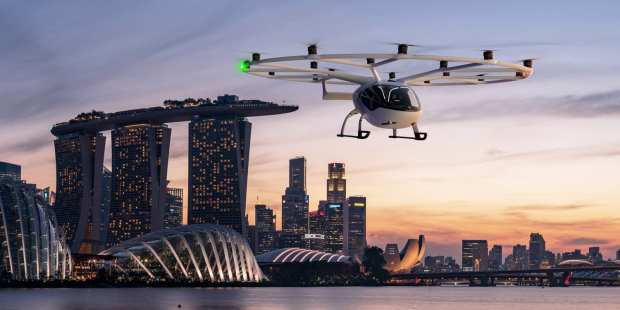Uber And Lyft Off: Air Taxis Become Grounded In Reality

Everyone’s been there. Sitting in the backseat of a rideshare vehicle, or maybe in the driver’s seat of a car, desperately looking back and forth between the clock and the stopped dead traffic in whatever major metro in which the workplace, meeting or flight is located.
But not everyone in said stressful situation has turned their eyes skyward and fantasized about a world where one could somehow float above all this traffic and go instantly to the airport that in real distance is less than 10 miles away.
Christian Bauer is one of those people that has looked to the sky. And someday soon in urban centers all over the world, that dream will be a reality. Bauer, chief commercial officer at air taxi development and manufacturing company Volocopter told PYMNTS that his company is building the world’s first sustainable and scalable urban air mobility business to make air taxi services available to tourists and business travelers in megacities like Paris, Tokyo and Singapore. The battery technology necessary to support the firm’s proprietary electric-powered, vertical take-off and landing (VTOL) aircraft has finally arrived to make it affordable for mass-market use in the next two or three years.
“As we are battery-driven, we are very dependent on the cell density and battery density,” he said. “And when you see the developments with Tesla and what they predict is happening over the next three years, capacity will nearly double. So, our range will increase without having more payload, just by changing the cells. And with today’s battery technology, the crafts can already go 35 kilometers [about 22 miles]. If the density gets better, the next two to three years driven by automation, we can benefit from that instantly.”
But even if the technology doesn’t level up, it’s still adequately developed for the megacity use case Volocopter was designed to support. There are two main customer personas that the firm believes it will be trying to win. The first is business travelers and commuters looking for a faster, better way to make it from their location at an airport in an exurb directly to downtown. The second large groups are likely going to be tourists looking for both a better way to get around and a more interesting view of the city they’re visiting.
And Volocopter’s goal, Bauer explained, is larger than simply taking air taxis out of the realm of science fiction and into the realm of day-to-day experience. He said he wants to use the technology as the starting point for an entire travel ecosystem for the millions and millions of people scrambling from point A to point B in cities worldwide. When they think of an ecosystem, the goal is to offer access to the city’s interconnected transportation network — from ridesharing drivers to trains, electric scooters and beyond.
“We want to connect to authorities,” he said. “We want to connect to the infrastructure and manage our fleets properly. We want to be connected to the air traffic management systems that are in place. We also want, of course, to connect to our partners and third parties. These are all the points you need to bring into the network and the platform to make urban air mobility a factor.”
And it will indeed be a factor in the market, but not a disruption. Bauer said that personally, he doesn’t care for the term “disruption” given its rather extreme tendency to be overused in describing any new idea. But more importantly, the reality is that air taxi isn’t going to be the best choice for every possible urban journey. A consumer going a short distance might well be better served by an electric scooter or a traditional ridesharing arrangement.
Plus, he said, while the goal is to someday be producing VTOL aircrafts by the tens of thousands, Volocopter is talking about cities with 10 million people making hundreds of million trips per year. The company isn’t going to be able to take on all of that traffic in the system. The goal is to lessen it and create a better aerial path for some journeys, not all of them.
“In Singapore, there are 360 million rides trips or taxi trips per year, and we will not have 360 million flights per year,” he said. “We’ll have a fragment of that, but on those routes where maybe on the road you will not succeed, you can look up to fly and enjoy a new service.”
People aren’t the only things the business is being designed to fly, he said. Volocopter is also developing a cargo variant of its device that is essentially a drone that can take on much larger than normal payloads of 200 kilograms (about 440 pounds).
It is why DB Schenker, one of the largest logistic providers worldwide, invested in Volocopter, as it is keen to leverage this technology for things like island deliveries, which currently present a logistics hassle. There are a lot of places, Bauer said, where a plane, helicopter or car won’t quite work, and Volocopter’s technology will prove to be a perfect fit.
That’s true especially now, he noted, as regulators worldwide are increasingly catching on to the idea that a world is emerging where aircraft vehicles can’t be neatly slotted into the category of airplane or helicopter — and will be designed for single riders over short distances instead of lots of riders going a long way.
And while it won’t be built overnight — the technology that will actually do the transporting is still being built — it is coming sooner than one would have even imagined a decade ago. The dream of being able to soar above the overly congested ground has been around for a long time, Bauer said, but the technology has finally caught up to the dream, which means all that’s left to do is build it.
